
Aug 31 – Sept 25, 2006
Cusco – Machu Picchu – Maras – Urcos – Ocongate – Quince Mil – Laberinto – Puerto Maldonado – Tambopata Reserve – Tumbes
After indulging in Cusco’s countless eateries, it was time to tick off another attraction on our “to do list”. Discovered
for the western world in 1911 by Yale archaeologist, Hiram Bingham, Machu Picchu has since become the number one tourist
attraction in South America. To prove the point: Darina wasn’t the first from Moydow to visit!
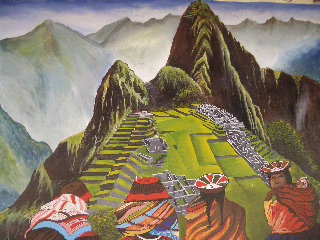

This amazing Inca citadel is perched atop a ridge with a deep valley of lush jungle below and huge rock outcrops dotted around for fun. Hidden for centuries, many questions still surround this mysterious site.
Machu Picchu is composed of two main zones: agricultural, with crop terraces and food storage barns; and urban, consisting of palaces, temples, squares and star-gazing observatories. Both areas are prime examples of the Incas’ superb stone masonry.


Huayna Picchu, one of the outcrops, is a perfect viewing platform for this extraordinary example of landscape architecture.
The tourist trail from Cusco to Machu Picchu has become as overrun as expensive. The 4-day Inca hiking trail is booked out months ahead and for the price they charge, you’d expect to be shuttled in by helicopter! The direct train for this 120km trip is no less than US$ 70 per person backpacker class.


We chose an alternative trail (most definitely also trodden by Incas many centuries ago) that cost a mere US$ 7 one way. This involved a couple of Inca bus rides, low-tech Inca cable-car river crossings, Inca jungle trails and serious thigh-toning Inca stone steps! What a beautiful entrance to this magnificent site.
This region was another one with a high cyclist density. Now is the season to meet those who started their trip in Alaska last summer like Jeanette and Gerrit from Holland and Harold from Germany. We also bumped into our youngest cyclists to date. Silvano from Turin, Italy was touring the area with his two charming daughters Giuli (14 years old) and Emily (12 years old).

On our way back, we did a little detour from Ollantaytambo to Maras

Here, the Salineras or salt pans, dating back to the Inca period of the 15th century, are fascinating. A natural salty spring is channelled into 5,000 salt pans, terraced into the mountain side. In the dry season, through an ancient evaporation process, salt crystals of 3 qualities remain for collection. This whole industry provides 400 20% jobs to the local community.
Back in Cusco, it was festival time again and La Virgin de Navidad was paraded around town with lots of music and dancing and drums and alcohol.

Peru is the third largest South American country after Brazil and Argentina and about the size of France, Spain and the UK combined.

Stretching from sea level up to over 6,000masl, it’s only normal that it boasts varying landscapes, climates and cultures. To experience landscape bombardment in a short stretch, wechose to cycle the Inter- Oceánica route down to the jungle in Puerto Maldonado. With a detailed hand-drawn map and lots of helpful advice from Jhon (MacawPeru travel) we were ready to hit the road.
Back tracking to Urcos, we stopped in Huaro to visit their frescoed church. To evangelize the illiterate, comic-like murals with scenes from heaven and hell with all the glory and gory you can imagine were painted on the walls in 1802. The torture is not confined to the masses either, as we can see a priest, bishop and cardinal submerged in a boiling cauldron.


A huge restoration project is now underway and painstaking work is showing its results in this unique temple.
From Urcos it was a 32 Km climb to the first 4,200masl pass. The ripio (gravel) track snaked up the mountain with numerous hairpin bends in ankle-deep bull dust. The gradient was fine, but the sandstorm towards the top was not at all appreciated.
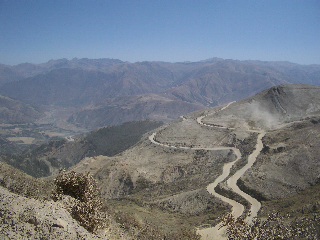


Hunger on the road…

The next day saw another 4,000m pass with beautiful views of Ausongate (6,372masl) and a few more snow-capped peaks.
The giggly-lampshade brigade was out in full force all morning heading into town to sell their wares. A pleasant downhill followed to Ocongate, where a colourful Sunday market was alive and happening.
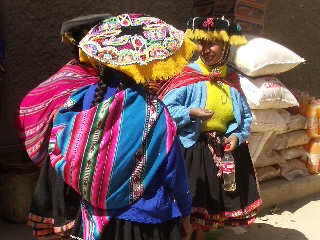



Our longest day to date was yet to come. As we followed the Río Mapocho upriver, we bade farewell to our last llamas and then climbed the Hualla Hualla pass.
This one, our highest so far, standing at 4,820masl, was actually enjoyable. With 9 other passes above 4,000masl under our belts, breathing was no longer an issue and we could actually sit back and enjoy the views...

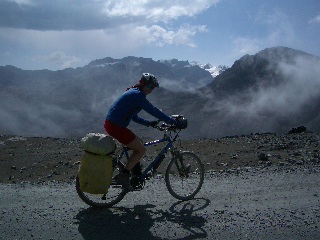

… when there were any!

By the time we hit Marcapata at 3,150m we had been pedalling for over 8 and a half hours and so the local thermal baths were much appreciated. The whole idea of cycling this road was to experience the dramatic changes in climate and landscape. By the time we reached Puerto Maldonado, we had certainly been exposed to most of the 28 climates Peru is prone to. As we left Marcapata, we still had a view of snow-capped peaks, but 70Km later we were in the Amazon jungle at 600masl. What a downhill!
From thermals and 4 blankets in bed to a mosquito net at most, from ski gloves and woolly hats to sun block and insect repellent it was a very pleasant dramatic change. The smells became more intense in the humid heat and the bird cries more than just whistles and squawks. A fantastic concerto grosso accompanied us as we rode through a 20m high canopy of vines and greenery.


Peru, with over 1,200 species of butterflies holds the world record. Cycling through the jungle was a sensational visual experience, especially where streams crossed the road and butterflies were in abundance.

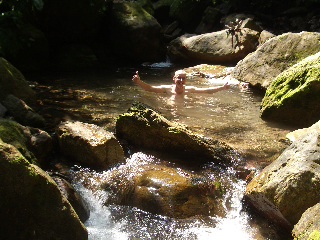
This crossing of streams became quite routine and shady rock pools were more than welcome to cool off in the midday heat.
Amazon vegetation can come in very handy as a sunshade, just as Chilean vegetation on the Carretera Austral protected us from rain.
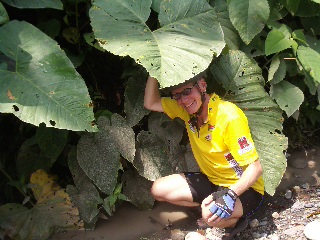
Another exotic aspect of the region is the ongoing gold rush that results in as many shops buying gold (oro) as stalls selling bananas and papayas.


We’ve all heard about the destruction of the Amazon rainforest in favour of agriculture. Fortunately, this “progress” hasn’t left a marked impression on Peruvian Amazonia to date. The Inter-Oceánica road project (2006-2011) will possibly change all of this and so we feel very privileged to have cycled this route in its rugged gravel and lush jungle state.

After about 500km of gravel, our bikes were in an awful state with mud and sand disguising their royal blue colour. Kurt took to the shower with his wheels… now is that love, or what?
Puerto Maldonado is a 3-country frontier town, where Peru borders Brazil and Bolivia in the Amazon basin. It is also a starting point for trips into the jungle, accessible by boat on the Madre de Dios and Tambopata rivers. We decided to spoil ourselves and booked 4 days in the Inotawa Lodge on the Tambopata River. This was a real luxurious way to explore the surrounding jungle and we enjoyed every minute.
With our personal guide, Michael we went in search of wildlife and birdlife, while marvelling at huge trees and vines, allwith medicinal properties. One of the most curious trees we came across was the walking tree. Sending out new aerial roots and allowing the old ones to die, this tree can actually change position in search of more light.

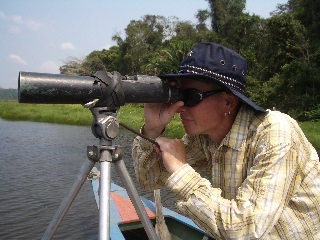
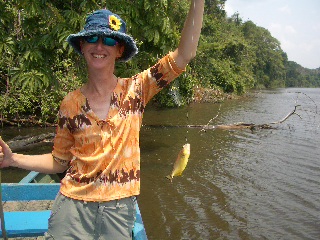
Bird watching escapades were very entertaining with woodpeckers, kingfishers,parakeets, parrots,macaws and 100s of other colourful and funny-feathered friends.
With 007 licences and fishing rods at hand, we headed off to an ox-bow lake to bring some cuddly pirañas to light. Darina was successful
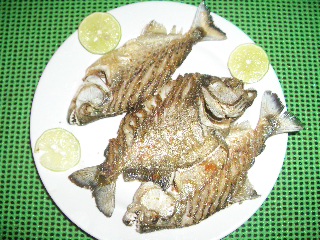
…and we had fish for lunch!
The night walk exposed a whole new jungle of creatures and sounds and we came across a tarantula pursuing a baby frog for dinner.
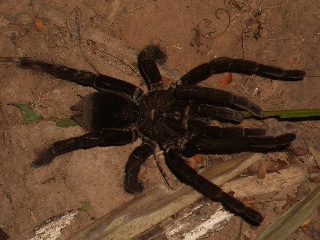

This one escaped!
Tropical fruits included bananas, papayas, star fruit, cacao, tree tomatoes and pineapples. Yum! Yum!


We did go for a dip in the muddy water of the Tambopata River, while caimans were still sleeping. A rellie of the fresh-water crocodile, caimans can measure up to 2m in length. Later, in the evening, we went out with torches caiman spotting and followed many red eyes in the dark. Unfortunately, due to our red-eye reduction function, the pictures look just like a Bolivian altiplano village at night!
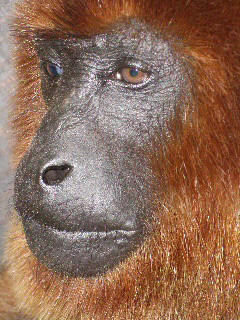
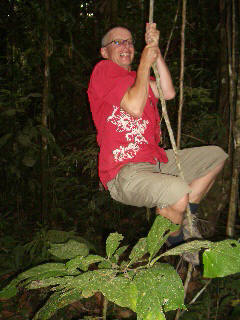

Who needs a bike?
Our original plan of cycling/boating through Amazonia up to Manaus, Brazil changed for 2 main reasons. An unfavourable ratio of jungle : grazing land was not enticing and flights from Manaus to Quito are prohibitively expensive. Having already had our fill of the altiplano and with the coastal route in Peru being grey with fog, we decided to skip the lot and head for the beach in Ecuador!

Aero Condor was a step ahead of the rest when it came to check in. No one before ever figured out how to weigh a bicycle, as it was always too big for the scales. José from Aero Condor however was cunning enough to jump on the scales himself and then take the bikes in hand one by one. Our 24kgs over weight were quickly discovered but in the jungle, who cares? No fines were imposed and our luggage was checked right through to Tumbes.
Flying to Tumbes, Peru, 30km short of Ecuador, we had a wonderful bird’s eye view of the meandering rivers and ox-bow lakes, snow capped mountains and serpentine bends that we had followed en route from Cusco. We covered our one-week trip in all of 30 minutes!

The leg from Lima to Tumbes held another surprise. A familiar Irish accent on the public address system reminded us of the wide variety of sandwiches and snacks available for purchase on board as well as the “Hertz rent-a-car deals for all Ryan Air customers!” Seemingly the plane waspurchased from Ireland’s own budget airline, but many months later, they still haven’t been able to locate the switch that turns Mary off!
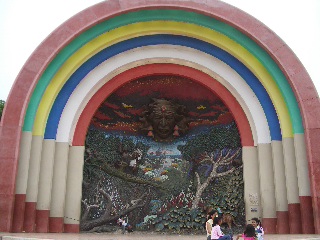
Tumbes is where Pizarro landed with his Spanish crew in the 1500s to commence his conquest of this New World. Today it is a busy town with colourful mosaics and monuments depicting the meeting of two cultures. It is also a great place for lobster, crab, black mussels and numerous sea fish from the Pacific Ocean.
Our 6 weeks in Peru were just a small sampling of what this diverse country has to offer, but we do feel we scraped the icing off the cake. From the altiplano and snow-capped mountains to the hot humid Amazon jungle, from ancient Inca architecture to traditional thatched houses, with giggling girls in ethnic costume on every turn in the road, Peru is certainly a fascinating, colourful destination.

